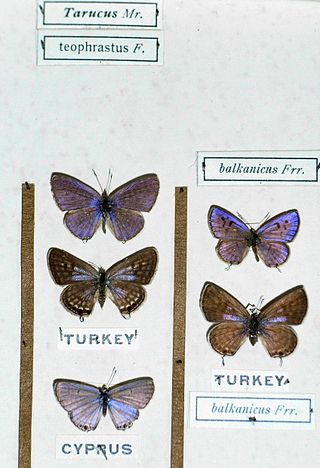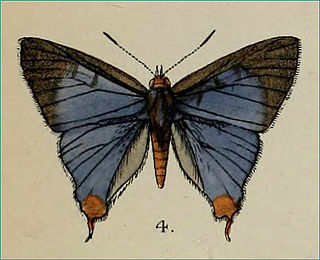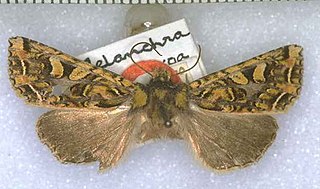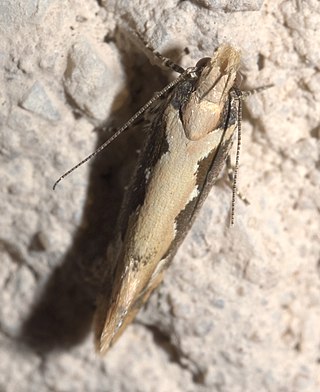
Apamea monoglypha, the dark arches, is a moth of the family Noctuidae. The species was first described by Johann Siegfried Hufnagel in 1766. It is a common, sometimes abundant, European species. It is found in most of Europe except northernmost Fennoscandia and the southern parts of the Iberian Peninsula and Greece. The species is also found in Anatolia, Turkestan, Western Asia and Central Asia, Siberia and Mongolia. In the Alps it is found up to heights of 2,500 meters. The smaller subspecies sardoa is found on Sardinia and Corsica.

Halpe homolea, the Indian ace or Ceylon ace, is a butterfly belonging to the family Hesperiidae.

Appias lalage, the spot puffin, is a small butterfly of the family Pieridae, that is, the yellows and whites, which is found in India, Indochina and Hainan.

Appias indra, the plain puffin, is a small butterfly of the family Pieridae, that is, the yellows and whites, which is found in south and southeast Asia.

Tarucus theophrastus, the common tiger blue, pointed Pierrot or African Pierrot, is a small butterfly found in the Old World tropics. It belongs to the lycaenids or blues family.

Cigaritis abnormis, the abnormal silverline, is a species of lycaenid or blue butterfly found in south India and Pakistan.
Acrocercops tripolis is a moth of the family Gracillariidae. It is known from Indonesia (Java).
Acrocercops lophonota is a moth of the family Gracillariidae. It is known from Java, Indonesia.

Meterana tetrachroa is a species of moth of the family Noctuidae. This species is endemic to New Zealand. It is classified as "Data Deficient" by the Department of Conservation.
Dichomeris delotella is a moth in the family Gelechiidae. It was described by August Busck in 1909. It is found in Mexico (Sonora) and the southern United States, where it has been recorded from Arizona and California.
Helcystogramma abortiva is a moth in the family Gelechiidae. It was described by Walsingham in 1911. It is found in Guatemala.
Helcystogramma juventellus is a moth in the family Gelechiidae. It was described by Thomas de Grey, 6th Baron Walsingham, in 1897. It is found in Jamaica and Mexico (Tabasco).
Recurvaria sticta is a moth of the family Gelechiidae. It is found in Mexico (Guerrero).
Faculta synthetica is a moth of the family Gelechiidae. It is found in Mexico (Sonora).
Battaristis symphora is a moth of the family Gelechiidae. It was described by Walsingham in 1911. It is found in Mexico (Tabasco).

Ornativalva erubescens is a moth of the family Gelechiidae. It was described by Walsingham in 1904. It is found in Morocco, Algeria, Tunisia, Libya, Egypt, Sudan, Israel, Saudi Arabia, Iran, Pakistan, and the southwestern U.S.
Eupragia solida is a moth in the family Depressariidae. It was described by Walsingham in 1911. It is found in Mexico, where it has been recorded from Tabasco.
Psittacastis incisa is a moth in the family Depressariidae. It was described by Lord Walsingham in 1912. It is found in Mexico (Tabasco) and Panama.
Psittacastis stigmaphylli is a moth in the family Depressariidae. It was described by Lord Walsingham in 1912. It is found on Jamaica.

Trachypepla protochlora is a moth of the family Oecophoridae first described by Edward Meyrick in 1883. It is endemic to New Zealand and is found in both the North and South Islands. The preferred habitat of this species is native forest and adults are on the wing from October until February. Adults can be variable in their green shaded colour as well as in the intensity of markings on their forewings. The greenish ground colouration of this moth ensures they are well camouflaged when at rest on green mosses and lichens.








